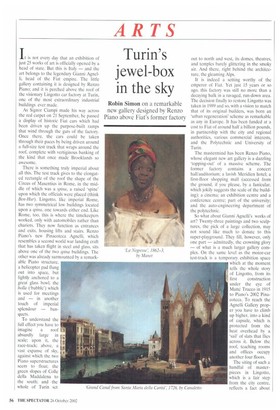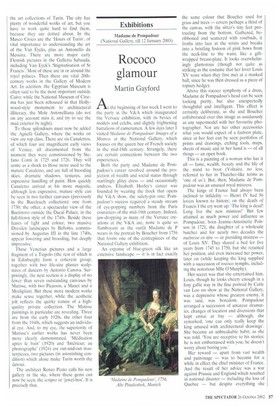Turin's jewel-box
in the sky Robin Simon on a remarkable new gallery designed by Renzo Piano above Fiat's former factory
t is not every day that an exhibition of just 25 works of art is officially opened by a head of state. But this is Italy — and the art belongs to the legendary Gianni Agnelli, head of the Fiat empire. The little gallery containing it is designed by Renzo Piano; and it is perched above the roof of the visionary Lingotto car factory at Turin, one of the most extraordinary industrial buildings ever made.
As Signor Ciampi made his way across the red carpet on 21 September, he passed a display of historic Fiat cars which had been driven up the purpose-built ramps that wind through the guts of the factory. Once there, the cars could be taken through their paces by being driven around a full-size test track that wraps around the roof, complete with vertiginous banking of the kind that once made Brooklands so awesome.
There is something truly imperial about all this. The test track gives to the elongated rectangle of the roof the shape of the Circus of Maxentius in Rome, in the middle of which was a spina, a raised 'spine' upon which the officials were placed (think Ben-Hur). Lingotto, like imperial Rome, has two symmetrical low buildings located upon a spina, one towards either end. Like Rome, too, this is where the timekeepers worked, only with automobiles rather than chariots. They now function as entrances and exits, housing lifts and stairs. Renzo Piano's new Pinacoteca Agnelli, which resembles a second world war landing craft that has taken flight in steel and glass, sits above one of the two spina buildings. The other was already surmounted by a remarkable Piano structure. a helicopter pad flung out into space, but lightly anchored to a great glass bowl, the bolla ('bubble') which is used for meetings and — in another touch of imperial splendour — banquets.
To understand the full effect you have to imagine a roof absurdly large in scale; upon it, the race-track; above, a vast expanse of sky. against which the two Piano superstructures seem to float; the green slopes of Colle della Maddalena to the south; and the whole of Turin set out to north and west, its domes, theatres, and temples barely glittering in the smoky air. And there, right behind the architecture, the gleaming Alps.
It is indeed a setting worthy of the emperor of Fiat. Yet just 15 years or so ago, this factory was still no more than a decaying hulk in a ravaged, run-down area. The decision finally to restore Lingotto was taken in 1989 and so, with a vision to match that of its original builders, was born an 'urban regeneration' scheme as remarkable as any in Europe. It has been funded at a cost to Fiat of around half a billion pounds, in partnership with the city and regional authorities, various commercial interests, and the Polytechnic and University of Turin.
The mastermind has been Renzo Piano, whose elegant new art gallery is a dazzling 'topping-out' of a massive scheme. The former factory contains a concert hall/auditorium; a lavish Meridien hotel; a first-floor shopping mall (accessed from the ground, if you please, by a funicular, which jokily suggests the scale of the building): a cinema; an exhibition centre and a conference centre; part of the university; and the auto-engineering department of the polytechnic.
So what about Gianni Agnelli's works of art? Twenty-three paintings and two sculptures, the pick of a large collection, may not sound like much to donate to this super-playground. They fill, however, only one part — admittedly, the crowning glory — of what is a much larger gallery complex. On the same level as the motor-car test-track is a temporary exhibition space which at the moment tells the whole story of Lingotto, from its first construction under the eye of Matte Trucco in 1915 to Piano's 2002 Pinacoteca. To reach the Agnelli Gallery proper you have to climb up higher, into a kind of capsule, which is protected from the heat overhead by a 'sail' of slats that flies across it. Below the roof, teaching rooms and offices occupy another four floors.
The siting of such a handful of masterpieces in Lingotto, which is a fair step from the city centre, reflects a fact about the art collections of Turin. The city has plenty of wonderful works of art, but you have to work quite hard to find them, because they are dotted about. In the Museo Civico are the 'Hours of Turin', of vital importance to understanding the art of the Van Eycks, plus an Antonelio da Messina, There are more major early Flemish pictures in the Galleria Sabauda, including Van Eyck's 'Stigmatisation of St Francis'. Most of these are in or around the royal palaces. Then there are vital 20thcentury works in the Gallery of Modern Art. In addition, the Egyptian Museum is often said to be the most important outside Cairo; while the National Museum of Cinema has just been rehoused in that Hollywood-style monument to architectural illiteracy, the Mole Antonelliana (do not on any account miss it, and try to see the mad exterior by night).
To these splendours must now be added the Agnelli Gallery, where the works on view are top class. There are six Canalettos, of which four are magnificent early views of Venice. all documented from the moment they were commissioned by Stefano Conti in 1725 and 1726. They will come as a shock to those more used to the mature Canaletto, and are full of brooding skies, dramatic shadows, textures, and expressive handling of paint. How quickly Canaletto arrived at his more majestic, although less expressive, mature style can be seen in two further canvases (previously in the Buccleuch collection): one from 1730; the other, a spectacular view of the Bucintoro outside the Ducal Palace, in the full-blown style of the 1740s. Beside these feasts of light and colour, two massive Dresden landscapes by Bellotto, commissioned by Augustus III in the late 1740s, appear lowering and brooding, but deeply impressive.
These Venetian pictures and a large fragment of a Tiepolo (the rest of which is in Edinburgh) form a coherent group, together with two life-size plaster sculptures of dancers by Antonio Canova. Surprisingly, the next section is a display of no fewer than seven outstanding canvases by Matisse, with two Picassos, a Manet and a Modigliani. But these more modern works make sense together, while the aesthetic jolt reflects the quirky nature of a highquality private collection. The Matisse paintings in particular are revealing. Three are from the early 1920s. the other four from the 1940s, which suggests an individual eye. And, to my eye, the superiority of Matisse's earlier works has never been more clearly demonstrated. 'Meditation apres le bain' (1920) and Interieur; au phonographe' (1924) are out-and-out masterpieces, two pictures (in astonishing condition) which alone make Turin worth the detour.
The architect Renzo Piano calls his new gallery in the sky, where these gems can now be seen, the scrigno or `jewel-box'. It is precisely that.



















































































 Previous page
Previous page